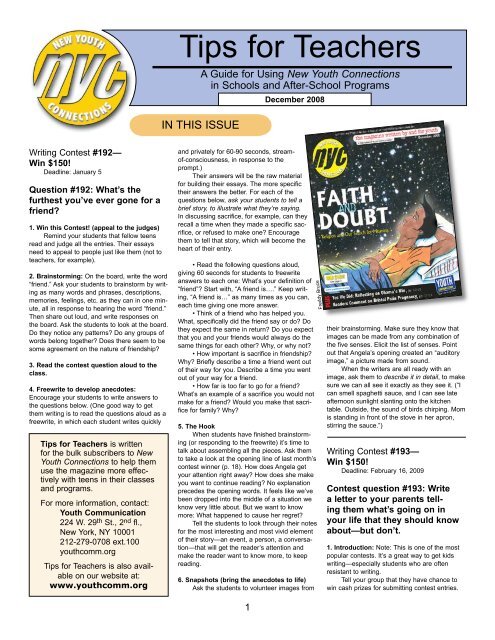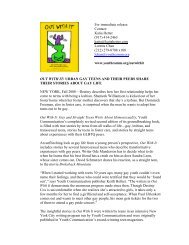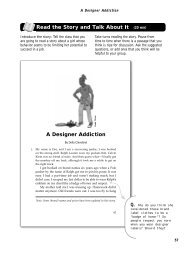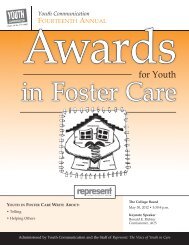Tips for Teachers - Youth Communication
Tips for Teachers - Youth Communication
Tips for Teachers - Youth Communication
Create successful ePaper yourself
Turn your PDF publications into a flip-book with our unique Google optimized e-Paper software.
<strong>Tips</strong> <strong>for</strong> <strong>Teachers</strong><br />
IN THIS ISSUE<br />
A Guide <strong>for</strong> Using New <strong>Youth</strong> Connections<br />
in Schools and After-School Programs<br />
December 2008<br />
Writing Contest #192—<br />
Win $150!<br />
Deadline: January 5<br />
Question #192: What’s the<br />
furthest you’ve ever gone <strong>for</strong> a<br />
friend<br />
1. Win this Contest! (appeal to the judges)<br />
Remind your students that fellow teens<br />
read and judge all the entries. Their essays<br />
need to appeal to people just like them (not to<br />
teachers, <strong>for</strong> example).<br />
2. Brainstorming: On the board, write the word<br />
“friend.” Ask your students to brainstorm by writing<br />
as many words and phrases, descriptions,<br />
memories, feelings, etc. as they can in one minute,<br />
all in response to hearing the word “friend.”<br />
Then share out loud, and write responses on<br />
the board. Ask the students to look at the board.<br />
Do they notice any patterns Do any groups of<br />
words belong together Does there seem to be<br />
some agreement on the nature of friendship<br />
3. Read the contest question aloud to the<br />
class.<br />
4. Freewrite to develop anecdotes:<br />
Encourage your students to write answers to<br />
the questions below. (One good way to get<br />
them writing is to read the questions aloud as a<br />
freewrite, in which each student writes quickly<br />
<strong>Tips</strong> <strong>for</strong> <strong>Teachers</strong> is written<br />
<strong>for</strong> the bulk subscribers to New<br />
<strong>Youth</strong> Connections to help them<br />
use the magazine more effectively<br />
with teens in their classes<br />
and programs.<br />
For more in<strong>for</strong>mation, contact:<br />
<strong>Youth</strong> <strong>Communication</strong><br />
224 W. 29 th St., 2 nd fl.,<br />
New York, NY 10001<br />
212-279-0708 ext.100<br />
youthcomm.org<br />
<strong>Tips</strong> <strong>for</strong> <strong>Teachers</strong> is also available<br />
on our website at:<br />
www.youthcomm.org<br />
and privately <strong>for</strong> 60-90 seconds, streamof-consciousness,<br />
in response to the<br />
prompt.)<br />
Their answers will be the raw material<br />
<strong>for</strong> building their essays. The more specific<br />
their answers the better. For each of the<br />
questions below, ask your students to tell a<br />
brief story, to illustrate what they’re saying.<br />
In discussing sacrifice, <strong>for</strong> example, can they<br />
recall a time when they made a specific sacrifice,<br />
or refused to make one Encourage<br />
them to tell that story, which will become the<br />
heart of their entry.<br />
• Read the following questions aloud,<br />
giving 60 seconds <strong>for</strong> students to freewrite<br />
answers to each one: What’s your definition of<br />
“friend” Start with, “A friend is….” Keep writing,<br />
“A friend is…” as many times as you can,<br />
each time giving one more answer.<br />
• Think of a friend who has helped you.<br />
What, specifically did the friend say or do Do<br />
they expect the same in return Do you expect<br />
that you and your friends would always do the<br />
same things <strong>for</strong> each other Why, or why not<br />
• How important is sacrifice in friendship<br />
Why Briefly describe a time a friend went out<br />
of their way <strong>for</strong> you. Describe a time you went<br />
out of your way <strong>for</strong> a friend.<br />
• How far is too far to go <strong>for</strong> a friend<br />
What’s an example of a sacrifice you would not<br />
make <strong>for</strong> a friend Would you make that sacrifice<br />
<strong>for</strong> family Why<br />
5. The Hook<br />
When students have finished brainstorming<br />
(or responding to the freewrite) it’s time to<br />
talk about assembling all the pieces. Ask them<br />
to take a look at the opening line of last month’s<br />
contest winner (p. 18). How does Angela get<br />
your attention right away How does she make<br />
you want to continue reading No explanation<br />
precedes the opening words. It feels like we’ve<br />
been dropped into the middle of a situation we<br />
know very little about. But we want to know<br />
more: What happened to cause her regret<br />
Tell the students to look through their notes<br />
<strong>for</strong> the most interesting and most vivid element<br />
of their story—an event, a person, a conversation—that<br />
will get the reader’s attention and<br />
make the reader want to know more, to keep<br />
reading.<br />
6. Snapshots (bring the anecdotes to life)<br />
Ask the students to volunteer images from<br />
Freddy Bruce<br />
their brainstorming. Make sure they know that<br />
images can be made from any combination of<br />
the five senses. Elicit the list of senses. Point<br />
out that Angela’s opening created an “auditory<br />
image,” a picture made from sound.<br />
When the writers are all ready with an<br />
image, ask them to describe it in detail, to make<br />
sure we can all see it exactly as they see it. (“I<br />
can smell spaghetti sauce, and I can see late<br />
afternoon sunlight slanting onto the kitchen<br />
table. Outside, the sound of birds chirping. Mom<br />
is standing in front of the stove in her apron,<br />
stirring the sauce.”)<br />
Writing Contest #193—<br />
Win $150!<br />
Deadline: February 16, 2009<br />
Contest question #193: Write<br />
a letter to your parents telling<br />
them what’s going on in<br />
your life that they should know<br />
about—but don’t.<br />
1. Introduction: Note: This is one of the most<br />
popular contests. It’s a great way to get kids<br />
writing—especially students who are often<br />
resistant to writing.<br />
Tell your group that they have chance to<br />
win cash prizes <strong>for</strong> submitting contest entries.<br />
1
Tell them that many of the letters <strong>for</strong> this contest<br />
reveal private in<strong>for</strong>mation so the essays will<br />
be published anonymously, and we’ll change<br />
details to conceal the writer’s identity. The winners’<br />
names will be chosen at random from all<br />
the entries, not just the ones we publish.<br />
PS: If you send a class set please make<br />
sure each entry has a name and address. (The<br />
name and address should be on a separate<br />
piece of paper so we can place them in a hat<br />
from which we draw the winners.)<br />
Please tell your students that the letters<br />
need not be about dramatic or sensational situations<br />
like contracting AIDS or contemplating<br />
suicide. Any situation or feeling can produce a<br />
letter that's likely to be published: breaking a<br />
plate, anger about not getting a gift, cutting a<br />
class, unspoken love <strong>for</strong> the parent or a sibling.<br />
On a humorous note, one year we published<br />
a letter from a son confessing that he was a<br />
Martian. (NOTE: Some of the young people in<br />
your class or group may not be living with their<br />
biological parents. Remind everyone that they<br />
can a write a letter to a guardian as well.)<br />
2. Warm-up discussion: Why don’t we tell<br />
our parents everything Ask your students,<br />
“What are some reasons <strong>for</strong> NOT telling your<br />
parents everything that’s going on in your life”<br />
(Possible answers might include “to stay out of<br />
trouble,” “because they wouldn’t understand,” “I<br />
need privacy,” “I don’t know what I want yet,” “I<br />
don’t know how to say it right.”)<br />
Ask them, “What things in general are<br />
teens reluctant to tell their parents”<br />
List their answers on the board.<br />
3. List of secrets: Next, ask them to list on a<br />
piece of paper as many “secret” things as they<br />
can, while assuring them that nobody will see<br />
any of the items except the one they finally<br />
choose to write about. You might want to list<br />
some of your own “secrets” you kept from your<br />
parents when you were a teenager (sneaking<br />
out at night, seeing the boy/girl they told you<br />
not to see, discovering your sexual orientation,<br />
dreaming of a career that no one thought you<br />
could have, wanting to change your name, etc.).<br />
4. Choose one to write about: Now, they look<br />
at the list, and choose the one item<br />
that gets to them the most. And<br />
<strong>for</strong> that one they should ask, “Why<br />
don’t your parents know this What<br />
stops you from telling them Why<br />
SHOULD your parents know this<br />
Have your kept it from them <strong>for</strong><br />
their sake, or <strong>for</strong> your sake Would<br />
it com<strong>for</strong>t you, in an ideal world, to<br />
have them know Why Do you<br />
need their help, their protection or<br />
advice, or do you need them to step<br />
aside and let you be”<br />
Maybe the scariest one isn’t the<br />
one the parents should know about,<br />
not right now. In that case, they can<br />
move along the list until they reach<br />
something that feels right. In either<br />
case, when they answer the above<br />
questions, they’ll have the core of<br />
their letters.<br />
5. First sentences to get them going: It might<br />
also help to give them some first sentence<br />
ideas. Here is a list from previous letters.<br />
● I'm writing you this letter to confront you about<br />
how I am feeling.<br />
● This is something that you never knew.<br />
● There is something I would like to tell you.<br />
● Ma, I am writing this letter to let you know all<br />
the things I did that you didn't know about.<br />
● First of all, I want to say, "I love you."<br />
● I have been more or less honest with you all<br />
my life.<br />
● I guess I'd like to think that I tell you everything,<br />
but…<br />
Discussion and Group Activity<br />
Faith and Death<br />
Talking to the Ceiling, by Percy Lujan, p. 3<br />
1. Be<strong>for</strong>e the activity: Be<strong>for</strong>e the class, write<br />
down each “Starter Question” listed below on a<br />
separate piece of paper or index card. You will<br />
need a blackboard and chalk.<br />
2. Introduce the activity: Tell your group they<br />
are going to read a story about a teen who<br />
Get More Teaching Resources at the <strong>Youth</strong><br />
<strong>Communication</strong> Website (www.youthcomm.org)<br />
• You can order dozens of<br />
books and teacher guides on topics<br />
your students are interested<br />
in.<br />
• You can download over<br />
250 stories from past issues of<br />
New <strong>Youth</strong> Connections and<br />
Represent: The Voice of <strong>Youth</strong> in<br />
Foster Care.<br />
• You can download lesson ideas<br />
from past issues of “<strong>Tips</strong> <strong>for</strong> <strong>Teachers</strong>.”<br />
• You can find out about writing<br />
workshops <strong>for</strong> young people in<br />
foster care.<br />
• You can browse our book<br />
and DVD catalog and order from<br />
our e-store.<br />
• You can have your students<br />
enter our writing contests.<br />
2<br />
thinks about the connection between religion<br />
and death. You will also ask the group to write<br />
the author a letter that might be published in the<br />
next issue of New <strong>Youth</strong> Connections magazine.<br />
3. Read aloud from one passage to get them<br />
interested: Hand out the issue and ask them<br />
to turn to page 3. Read aloud the passage that<br />
starts with “When I arrived…” in the fourth column,<br />
and ends with “I went to the living room to<br />
sit with the woman.”<br />
Ask the class what about this passage<br />
stands out. Call their attention to the powerful,<br />
specific description of the dying man. Ask them<br />
why Percy provides such a detailed description.<br />
What do the details make them feel What does<br />
putting these details into the story reveal about<br />
Percy: Is he compassionate Fearful Morbid<br />
4. Group work, reading, and discussion:<br />
Divide the class into four groups. (Note: They<br />
will be reading the story in the group so include<br />
one stronger reader in each group.) Ask them<br />
to choose one of the following question papers<br />
from a box or hat. (Be<strong>for</strong>e the class, cut up the<br />
questions and put them in the hat. You can use<br />
two copies of some questions if you have more<br />
than four groups.)<br />
Tell your groups to read the story aloud<br />
and then choose a group leader to take notes<br />
<strong>for</strong> a discussion. They are to list as many<br />
answers and explanations of answers as they<br />
can generate in 15 minutes. All answers must<br />
be supported by an example from the article or<br />
from life. There must be at least one example<br />
drawn from the article <strong>for</strong> each group.<br />
5. Present results: Groups take turns presenting<br />
the results, with each member giving at<br />
least one answer-with-example to the whole<br />
class. The class asks follow-up questions<br />
requesting more details, and makes connections<br />
to their own presentations and their own<br />
lives. You can map this on the board. Write<br />
short notes with the issues and examples from<br />
each group; then draw lines where the class<br />
has noted connections. At the end, you’ll have<br />
filled the board with connections.<br />
Yong Han Chen
6. Write a letter to Percy: Do you agree with<br />
his attitudes about death and religion What<br />
do you think about his witnessing someone’s<br />
death Have you ever felt the same emotions<br />
he describes about religion<br />
Starter Questions<br />
A. Why do you think Percy thinks about<br />
death when he thinks about religion<br />
What do you think about the connections<br />
between religion and death<br />
B. How can a person believe something<br />
is true yet have feelings that maybe<br />
it isn’t true Do you think Percy will<br />
someday change his mind and believe<br />
in God Do you think he’s confused<br />
What is an issue or belief that you have<br />
been confused about<br />
C. How does Percy’s view of death<br />
and the role of death in the world differ<br />
from some religious believers How is<br />
it similar or how does it differ from your<br />
own views<br />
D. What does Percy think about the<br />
beliefs of religious people Is it right <strong>for</strong><br />
him to com<strong>for</strong>t people by saying things<br />
that he maybe doesn’t believe in Have<br />
you ever told somebody something<br />
that you didn’t really believe in order to<br />
make him or her feel better Was it right<br />
to do that Why or why not<br />
Letter Writing Activity<br />
Understanding Others<br />
Wearing My Faith, by Orruba<br />
Almansouri, p. 5<br />
Introduction: Tell your group they<br />
are going to read a story by Orubba,<br />
a Muslim girl who wears a hijab. Ask<br />
them if they know what a hijab is. Tell<br />
them that many religions expect their<br />
adherents to wear certain clothes and<br />
point out that the story on page 12<br />
“Alone with the Mountain,” is written by<br />
an Orthodox Jewish girl who was told<br />
how to dress.<br />
1. Be<strong>for</strong>e reading the story: Ask<br />
your students what outward signs<br />
of religious faith they have noticed:<br />
yarmulkes, crosses, Sunday clothes,<br />
turbans, ashes on <strong>for</strong>ehead <strong>for</strong> Ash Wednesday,<br />
Hasidic Jewish men’s black hats and coats,<br />
Muslim men’s beards, etc. Ask students to list<br />
other prominent signs of belonging or loyalty:<br />
gang beads, fitted baseball hats, wedding rings,<br />
chains, Jordan sneakers, Nike swooshes, tattoos,<br />
national flags, etc. What does each represent<br />
Do your students wear anything that<br />
represents their bond to a group or belief<br />
2. Read the article aloud: Asking the students<br />
to stop you when they notice evidence of the<br />
author’s tolerance <strong>for</strong> other people’s beliefs.<br />
Ask the class if they have ever felt intolerant<br />
towards someone else’s difference, or if someone<br />
has been intolerant of them.<br />
• What do they think of her outward show of<br />
faith<br />
3. Ask your students to write a letter to<br />
Orubba: What do they admire about her commitment<br />
to her faith Can they identify with<br />
her Can they tell her a story about their own<br />
uniqueness under scrutiny Do they have any<br />
questions <strong>for</strong> her: Why does she go as far as<br />
she does Wouldn’t it be okay with just a token<br />
representation of faith Why aren’t Muslim<br />
boys clothed like she is Does she think female<br />
beauty is a distraction in this country<br />
Terrence Taylor<br />
Reading and Writing Lesson<br />
Metaphor, Simile,<br />
Personification<br />
Alone With the Mountain, by Marci Bayer, p. 8<br />
Be<strong>for</strong>e the activity: Write the quotes from<br />
the poets Ezra Pound and Robert Burns (below)<br />
on the board.<br />
1. Introduction: Tell your group there are two<br />
parts to this activity. In the first one they will<br />
examine how Marci used sensory details, metaphors,<br />
similes and personification in her story.<br />
The second part of the lesson asks them<br />
to read an article about a “turning point” and<br />
then write about an important moment in their<br />
own lives.<br />
2. Read aloud to notice senses & description:<br />
Read the eight paragraphs that begin, “As<br />
everyone loaded heavy packs…” and ends with<br />
“…curved inward like a wave,” (p. 9, columns 1<br />
and 2)<br />
Ask your group to identify all the sensory<br />
images in this passage. (This small section<br />
presents tastes, smells, temperature and sights.<br />
Name the five senses. What senses are not<br />
included here Why do writers use sensory<br />
details to describe their experiences to readers)<br />
3. Identify simile, metaphor, personification:<br />
Ask the group how they react to the sentence:<br />
“The desert was flat and dry.” (You are looking<br />
<strong>for</strong> them to say “Big deal” or “What else is<br />
new”) Then ask them to react to “The desert<br />
was like a dry ocean.” What is their reaction<br />
Ask them if they have ever seen a real desert.<br />
How many have seen a picture of one<br />
or movie scenes set in deserts What are the<br />
similarities between an ocean view and a desert<br />
view (Vast, shimmering on a sunny day, rippling,<br />
seemingly endless, welcoming, lonely,<br />
etc.). Is “The desert was like a dry ocean” a<br />
metaphor or a simile Explain the difference.<br />
(It’s a simile because it uses the word “like.”)<br />
Point out the Ezra Pound quote from the poem<br />
“Cino”:<br />
I will sing of the white birds<br />
In the blue waters of heaven<br />
The clouds that are spray to its sea.<br />
What things are being compared here<br />
Does the sky ever look like the ocean Do<br />
clouds ever look like sea spray<br />
Notice the personification of the desert sky<br />
as lonely and patient, taking on human characteristics.<br />
This is another powerful way to give a<br />
reader your experience of something, the “personality”<br />
of the situation. Here is an example<br />
3<br />
of simile from the song “A Red, Red Rose” by<br />
Robert Burns:<br />
O my Love’s like a red, red rose,<br />
That's newly sprung in June.<br />
O my Love's like the melody,<br />
That's sweetly play'd in tune.<br />
Turning Point Essay<br />
Ask your students to think of an experience<br />
that was a turning point in their lives,<br />
towards better or worse. They’re to describe it<br />
using so much sensory detail and such vivid,<br />
unexpected similes that they make the reader<br />
connect with them, mind to mind.<br />
Tell them to paint pictures with words,<br />
make the reader taste, touch, smell, hear and<br />
see what we experience. If they can relate their<br />
perception to something the reader already<br />
knows (through simile or metaphor or personification),<br />
they’ll make a mind-to-mind connection.<br />
• Just be<strong>for</strong>e they start, read the final paragraph<br />
of the article aloud. Note the sentence,<br />
“Everybody has their own way of seeing what’s<br />
in the universe.” Point out that by writing so<br />
vividly and in such detail, Marci has made us<br />
appreciate her way of seeing. Your students can<br />
do the same.
Vocabulary Party<br />
Rejecting My Religion, by Anonymous, p. 6<br />
1. Preparation: Write the vocabulary words<br />
and phrases from this story (below) on separate<br />
pieces of paper. Write matching definitions on<br />
another piece of paper. Have students line up,<br />
backs to you. Tape one paper to each student’s<br />
back. Some get words; others get definitions.<br />
(Note: If you don’t use all the words, make sure<br />
not to use definitions <strong>for</strong> words that you don’t<br />
use.)<br />
2. Meet people, learn new words: Tell them<br />
they’re at a party. They can have music, dancing,<br />
games, anything they come up with (and<br />
that you can abide), as long as they adhere to<br />
the main goal: learning new words by meeting<br />
people. They learn by trying to find their sole<br />
true partner, who carries either a word or a definition<br />
that matches their own. To do this, they<br />
have to go around asking yes or no questions<br />
Words and Phrases Definitions<br />
• Perpetual=Continuing <strong>for</strong>ever<br />
• Adorned=Decorated<br />
• Instilled a fear=Made someone very<br />
scared<br />
• Premier=First in rank or position<br />
• Ritual=Ceremony<br />
• Petty=Having little importance<br />
• Adapt=Adjust or make fit<br />
• Expansive=Increasing the volume or<br />
amount<br />
• Omnipotent being=All powerful entity<br />
• Hypocrisy=Pretending to be what you<br />
are not<br />
• Epic=Heroic<br />
• Segregated=Set apart from others<br />
• Justified=Shown to be right, just or reasonable<br />
• Inferior=Of less importance or quality<br />
• Insecurities=Lack of confidence<br />
• Scripture=A collection of sacred writings<br />
Lee Samuel<br />
about what is stuck to their own back. Only yes<br />
or no questions! This strengthens strategies of<br />
inquiry.<br />
Students may use dictionaries, when<br />
they’re ready, to help someone else, or to find a<br />
definition to help themselves, or to help another<br />
person so that that person can correctly figure<br />
out his or her word and the two of you can get<br />
together.<br />
When they’ve found their partner, they go<br />
around helping other people find each other. By<br />
this time, most people will have encountered all<br />
the words and definitions. But <strong>for</strong> review, ask<br />
each pair to introduce themselves to the rest,<br />
and use themselves in a sentence.<br />
When this activity is over, read the article<br />
aloud. Ask if there were any surprises, as far as<br />
using the new words is concerned. Note that in<br />
the article, the author’s quest is one <strong>for</strong> learning.<br />
He says, “All I wanted to do was learn.”<br />
Has learning ever felt risky to any of your<br />
students What risk did they have to take in the<br />
pre-reading activity, in order to learn How did<br />
this relate to risks they take in their daily lives<br />
What’s the biggest risk they’ve ever taken<br />
What did they want What did they stand to<br />
lose What happened This can become a personal<br />
essay, or a letter to the author.<br />
Election Response<br />
Treasure Hunt<br />
Yes We Did: Obama’s Historic Win, various<br />
authors, p. 12-15<br />
Be<strong>for</strong>e the lesson: Copy the items in the<br />
list below on the blackboard.<br />
Set up the treasure hunt<br />
• Divide class into a few groups of three to four.<br />
• Give each group a single copy of the issue.<br />
• Tell them they’re going to have a treasure-hunt<br />
competition. Each group will race against the<br />
others to find the items listed below.<br />
• The catch Only one copy of the issue per<br />
group. They need to come up with cooperative<br />
strategies <strong>for</strong> sharing the in<strong>for</strong>mation and finding<br />
answers in a nonlinear way.<br />
• Tally the totals after 15 minutes. Have each<br />
group read their finds aloud and compare them<br />
to other groups, to achieve total coverage <strong>for</strong><br />
the class.<br />
Find These Items<br />
● Who stood and waited to vote with her<br />
grandmothers<br />
● Who liked Obama because he wears North<br />
Face<br />
● Who came back home to New York to vote<br />
● Who worried about assassination<br />
● Which neutral journalist was overcome by<br />
emotion<br />
● Who used a metaphor about caged birds<br />
● Whose mother took a picture of her at the<br />
voting booth<br />
● Who was surrounded by McCain supporters<br />
at her school<br />
● Who was worried about high expectations<br />
● Who watched the election on the Al Jazeera<br />
network<br />
● Whose father promised to hand out free food<br />
● Who says we should rethink the word<br />
“minority”<br />
● Who chatted on the computer with friends in<br />
England and Australia<br />
Rules <strong>for</strong> Life (Reflection Activity)<br />
Following My Own Commandments, by Tashiana Garrido, p. 23<br />
1. Have students read the article (individually or aloud).<br />
2. Form groups; generate commandments: After reading the article,<br />
ask students to <strong>for</strong>m groups of 3-5 people. Each group must generate<br />
its own list of commandments. Everyone in the group must agree with the<br />
commandments. Negotiation is significant here. Unless, of course, they<br />
want to defer to a single, dominant authority. These are rules they all want<br />
to live by, and try to live by.<br />
3. Easier said than done Discussion & Writing: Ask the teens if<br />
they have ever broken their own rules Have a brief discussion. Then ask<br />
each student to write a brief description either of how they’ve adhered to<br />
the group’s rules despite temptation or have broken a rule. How do they<br />
feel about the task of staying on task Is there guilt when they fail to follow<br />
a rule they think is important<br />
4. Submit your commandments! Collect each group's list of commandments<br />
and send them to Tashiana. (We may publish them if we<br />
have space.)<br />
Regents Prep<br />
Understanding Graphs<br />
Here are some questions you can ask students to help them become<br />
more com<strong>for</strong>table with graphs and timelines (see p. 6).<br />
What is the largest major religious group in New York (Catholic)<br />
What is smallest (Orthodox Christian)<br />
What is the largest major religious group in the world, according to<br />
the pie chart (Muslim)<br />
What is the smallest (Jewish)<br />
Are there more Christians or Muslims in the world (This is a tougher<br />
question: Student must add all the Christian groups together. They<br />
come to 34.3%, compared to 21% <strong>for</strong> Muslims. (Note that Muslims are<br />
not divided into the three main sects, Shi’a, Sunni & Sufism.) Explain to<br />
students that sometimes on the Regents or other tests they will be asked<br />
to make this kind of conceptual leap.<br />
Which three major religions predate Christianity<br />
4







